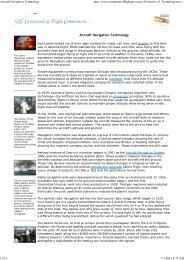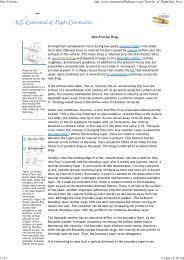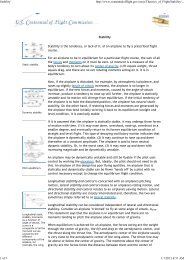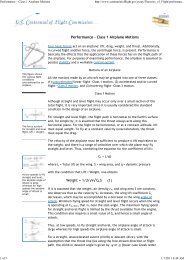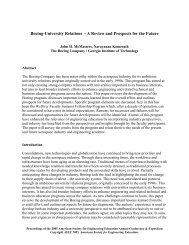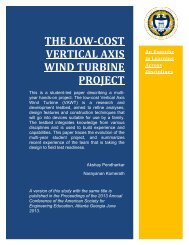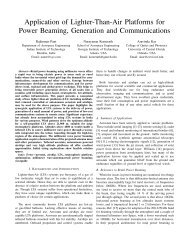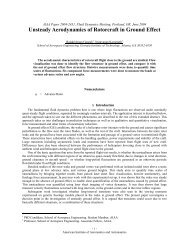Tip Vortex Formation and Evolution to the Near Wake of a Rotor in ...
Tip Vortex Formation and Evolution to the Near Wake of a Rotor in ...
Tip Vortex Formation and Evolution to the Near Wake of a Rotor in ...
Create successful ePaper yourself
Turn your PDF publications into a flip-book with our unique Google optimized e-Paper software.
espectively. Thompson also observed secondaryfeatures <strong>in</strong> <strong>the</strong> circumferential velocity pr<strong>of</strong>iles for earlywake ages. These were not unders<strong>to</strong>od at <strong>the</strong> time; atpresent we postulate that <strong>the</strong>se are a manifestation <strong>of</strong> <strong>the</strong>rollup <strong>of</strong> discrete vortical filaments dur<strong>in</strong>g <strong>the</strong> formation<strong>of</strong> <strong>the</strong> tip vortex. However, Thompson’s flowvisualization <strong>and</strong> measurements showed that <strong>the</strong> tipvortex <strong>of</strong> a ro<strong>to</strong>r does persist with much <strong>of</strong> its <strong>in</strong>itialstrength for large vortex ages.Br<strong>and</strong> et al [5,6] <strong>and</strong> Liou et al [7-9] exam<strong>in</strong>ed vortextrajec<strong>to</strong>ries <strong>and</strong> dynamics <strong>of</strong> <strong>the</strong> two-bladed ro<strong>to</strong>r used<strong>in</strong> <strong>the</strong> present paper, <strong>in</strong> forward flight <strong>in</strong> <strong>the</strong> same w<strong>in</strong>dtunnel. They showed, aga<strong>in</strong>, that vortex trajec<strong>to</strong>riesrepeated with precise periodicity, provided wakeimp<strong>in</strong>gement on <strong>the</strong> tunnel floor, <strong>and</strong> wakerecirculation, were prevented by go<strong>in</strong>g <strong>to</strong> sufficientlyhigh advance ratio (>0.06 <strong>in</strong> this experimentalconfiguration). Aga<strong>in</strong>, <strong>the</strong> vortex was seen <strong>to</strong> ma<strong>in</strong>ta<strong>in</strong>much <strong>of</strong> its <strong>in</strong>itial strength for vortex ages over 400degrees, which was <strong>the</strong> limit <strong>of</strong> <strong>the</strong>ir <strong>in</strong>terest because<strong>the</strong>y were study<strong>in</strong>g ro<strong>to</strong>r vortex/airframe <strong>in</strong>teraction.Komerath et al [10] extended <strong>the</strong> s<strong>in</strong>gle-bladed ro<strong>to</strong>rwith a double-swept blade tip <strong>in</strong> <strong>the</strong> 9-foot hover facilityat Georgia Tech <strong>to</strong> study effects at high pitch angles.Dur<strong>in</strong>g <strong>the</strong>ir experiments, <strong>the</strong>y observed that at certa<strong>in</strong>conditions, <strong>the</strong> tip vortices imp<strong>in</strong>ged on <strong>the</strong> edge <strong>of</strong> <strong>the</strong>wake <strong>in</strong>duc<strong>to</strong>r <strong>and</strong> recirculated <strong>in</strong> <strong>the</strong> facility: this wasassociated with <strong>the</strong> development <strong>of</strong> severe aperiodicjitter <strong>of</strong> <strong>the</strong> vortex trajec<strong>to</strong>ries.Funk et al [11] conducted extensive measurements <strong>of</strong><strong>the</strong> flowfield between <strong>the</strong> 2-bladed ro<strong>to</strong>r <strong>and</strong> a w<strong>in</strong>g <strong>in</strong><strong>the</strong> John Harper w<strong>in</strong>d tunnel. Although vortextrajec<strong>to</strong>ries were substantially altered by w<strong>in</strong>g<strong>in</strong>teraction, <strong>the</strong> results on periodic repeatability <strong>of</strong>vortex locations, <strong>and</strong> persistence <strong>of</strong> vortices <strong>to</strong> largeages, both rema<strong>in</strong>ed unchanged.Carradonna et al [12,13] visualized <strong>the</strong> wake <strong>of</strong> a 2-bladed ro<strong>to</strong>r <strong>in</strong> axial climb <strong>in</strong> <strong>the</strong> 30’x30’ Settl<strong>in</strong>gChamber <strong>of</strong> <strong>the</strong> 7’x 10’ w<strong>in</strong>d tunnel at Ames ResearchCenter. Aga<strong>in</strong> <strong>the</strong>y found that when wake recirculationwas prevented, <strong>the</strong> vortex trajec<strong>to</strong>ries repeated quiteperfectly from cycle <strong>to</strong> cycle <strong>of</strong> blade motion, even as<strong>the</strong> climb velocity was brought <strong>to</strong>wards zero. <strong>Vortex</strong>cores were discernible by <strong>the</strong> seed particle patterns forseveral turns <strong>of</strong> <strong>the</strong> vortex, until merger betweenvortices smeared <strong>the</strong> patterns. From <strong>the</strong> above, it is quiteclear that <strong>the</strong> tip vortex <strong>of</strong> a ro<strong>to</strong>r persists over longvortex ages. Also, aperiodic “jitter” <strong>of</strong> vortices is not abasic fluid mechanical feature <strong>of</strong> ro<strong>to</strong>r wakes, providedrecirculation is avoided.McAlister [14-15] studied <strong>the</strong> velocity field <strong>in</strong> <strong>the</strong> nearwake <strong>of</strong> a two-bladed ro<strong>to</strong>r <strong>in</strong> hover us<strong>in</strong>g a 3-component laser velocimeter. The test conditions were aC t <strong>of</strong> 0.005 at 1100 <strong>and</strong> 550 RPM. He found that threechords downstream <strong>of</strong> <strong>the</strong> blade <strong>the</strong> vortex me<strong>and</strong>er wasless than one core diameter. The me<strong>and</strong>er <strong>in</strong>creased byan order <strong>of</strong> magnitude by <strong>the</strong> time vortex reached 180°<strong>of</strong> vortex age. He also noted that chang<strong>in</strong>g <strong>the</strong> rotationalspeed did not have an effect on <strong>the</strong> core diameter, <strong>the</strong>general appearance <strong>of</strong> <strong>the</strong> trail<strong>in</strong>g vortex, or <strong>the</strong>magnitude <strong>of</strong> <strong>the</strong> velocity components relative <strong>to</strong> <strong>the</strong>tip-speed.In <strong>the</strong> late 1990s, measurements were reported byLeishman et al [16] us<strong>in</strong>g a s<strong>in</strong>gle-bladed ro<strong>to</strong>r <strong>in</strong> ahover facility, us<strong>in</strong>g a 3-component laser velocimeter.These measurements <strong>in</strong>dicated rapid “diffusion” <strong>of</strong> <strong>the</strong>tip vortices with<strong>in</strong> <strong>the</strong> first 90 degrees <strong>of</strong> vortex age.Substantial aperiodicity was observed. Thesephenomena were attributed <strong>to</strong> turbulence <strong>in</strong> <strong>the</strong> core,<strong>and</strong> <strong>the</strong> rapid smear<strong>in</strong>g <strong>of</strong> <strong>the</strong> vortex velocity pr<strong>of</strong>iledata was described as turbulent diffusion [16]. However<strong>the</strong> data acquisition procedures used had taken noaccount <strong>of</strong> aperiodicity, rais<strong>in</strong>g <strong>the</strong> possibility thatvortex pr<strong>of</strong>ile data, averaged over several cycles, hadbecome severely smeared by cycle-<strong>to</strong>-cycle uncerta<strong>in</strong>ty<strong>in</strong> vortex position. Conlisk et al [17] showed byanalytical arguments based on orders <strong>of</strong> magnitude thatturbulent diffusion was not a plausible explanation forvortex decay <strong>of</strong> <strong>the</strong> rate reported <strong>in</strong> Ref. [16].Mahal<strong>in</strong>gam et al [18-20] conducted measurements on<strong>the</strong> advanc<strong>in</strong>g blade side (ABS) <strong>of</strong> <strong>the</strong> two-bladed ro<strong>to</strong>rused <strong>in</strong> this paper, <strong>in</strong> low-speed forward flight. Heshowed by flow visualization <strong>and</strong> LDV measurementsthat <strong>the</strong> ro<strong>to</strong>r flow field was periodic <strong>to</strong> better than 1° <strong>of</strong>ro<strong>to</strong>r azimuth at an advance ratios 0.1. Hav<strong>in</strong>gestablished periodicity <strong>to</strong> ensure <strong>the</strong> quality <strong>of</strong> <strong>the</strong> data,he studied <strong>the</strong> near-blade flowfield as well as <strong>the</strong> nearwake. In <strong>the</strong>se measurements, he observed strongspanwise velocities directed <strong>to</strong>wards <strong>the</strong> blade-tip onboth <strong>the</strong> suction <strong>and</strong> pressure sides <strong>of</strong> <strong>the</strong> blade. Thevelocities approached 40% <strong>of</strong> <strong>the</strong> tip-speed on <strong>the</strong>pressure side. Spanwise flow on <strong>the</strong> suction side wasmuch lower. Mahal<strong>in</strong>gam also observed secondaryeffects <strong>in</strong> <strong>the</strong> circumferential velocity pr<strong>of</strong>iles dur<strong>in</strong>gformation. He showed that <strong>the</strong> turbulence level <strong>in</strong>side<strong>the</strong> core was lower than that <strong>in</strong> <strong>the</strong> freestream, as mightbe expected <strong>in</strong> a region <strong>of</strong> favorable pressure gradient.Both <strong>the</strong> vortex strength <strong>and</strong> <strong>the</strong> axial velocity <strong>in</strong> <strong>the</strong>core were shown <strong>to</strong> persist out <strong>to</strong> more than 500 degrees<strong>of</strong> vortex age.II.2 Previous Work on Seed Particle InertiaAs previously mentioned, velocity measurementtechniques that rely on seed particles carried by a fluidCopyright © American Helicopter Society. Presented at <strong>the</strong> 57 th AHS Forum, June 2001



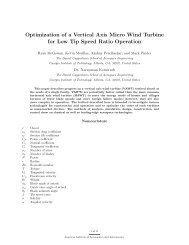
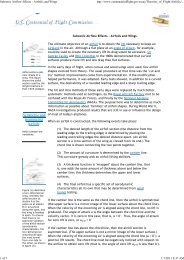

![p density of fluid, kg/m3 [Greek letter rho] V mean velocity of fluid, m ...](https://img.yumpu.com/50595898/1/184x260/p-density-of-fluid-kg-m3-greek-letter-rho-v-mean-velocity-of-fluid-m-.jpg?quality=85)
